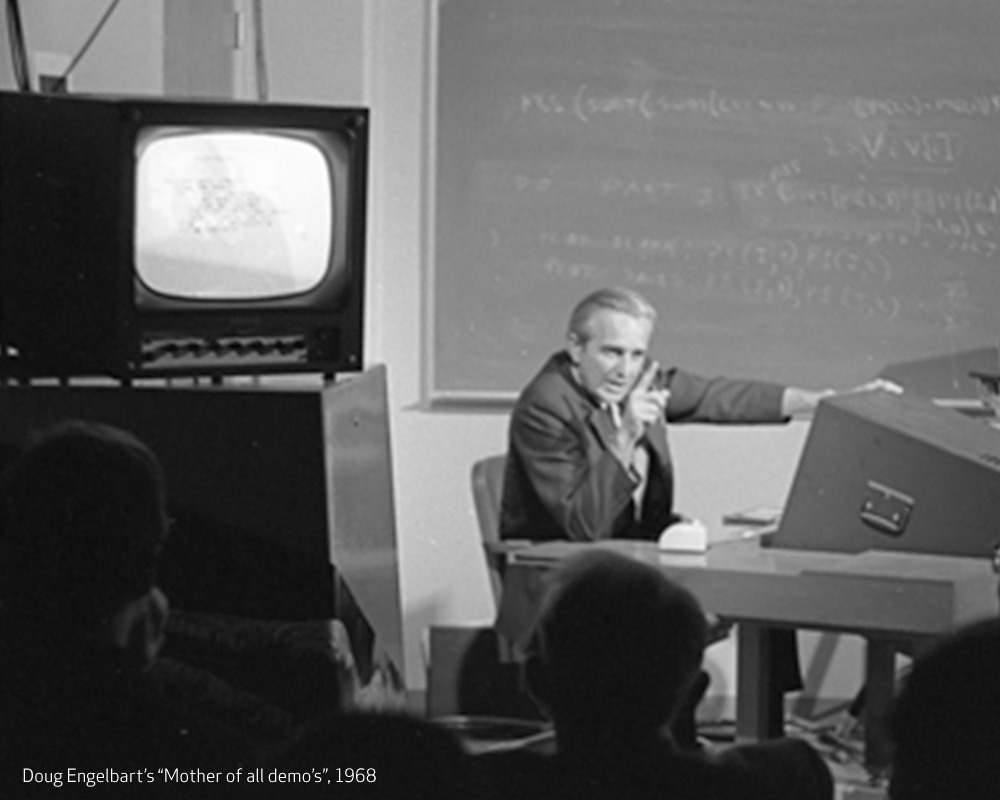

Maarten van Emden has a great piece on Douglas Engelbart and Intelligence Augmentation (IA) versus Artificial Intelligence (AI). First go read that piece then come back here :) This post follows up a bit and comments on some of what Maarten says.
Most people don't realize that much of the computer industry has been about the struggle between two worlds, Intelligence Augmentation and Artificial Intelligence
Most people don't realize that much of the computer industry has been about the struggle between two worlds, IA and AI. John Markoff has chronicled the tension between both of these well with his books What the Dormouse Said: How the Sixties Counterculture Shaped the Personal Computer Industry and his newest book, Machines of Loving Grace: The Quest for Common Ground Between Humans and Robots.
IA, or Intelligence Augmentation, is all about empowering humans with tools that make them more capable and more intelligent, while traditional AI has been about removing humans fully from the loop. The traditional torch bearer for IA is Douglas Engelbart, who laid the seeds for much of the Personal Computer revolution with his famous Mother of All Demos in 1968, where he demoed the computer mouse, hypertext, windowing, videoconferencing, and more for the first time. Douglas Engelbart was focused on creating empowering tools (and accelerating human evolution) that augmented our intellects.

I got a chance to work with Engelbart in 2006 for a year and a half as part of an NSF grant. I learned the original Augment/NLS system, learned how to use a chording keyboard, read many of his original papers, studied and filmed how Engelbart used his own Augment system, and interviewed many members of the Augment/NLS team. I then took some of this and re-implemented parts of it on the contemporary web as the HyperScope project. I essentially got a masters in many of Engelbart's ideas. You can learn more about this work here.
I personally think there can be a large amount of “golden lost age” thinking when it comes to Engelbart, Alan Kay, and people like Ted Nelson. I think they are great figures who have challenged the direction the industry has gone in, but I disagree that things have gone in a wrong direction. I'm happy that we got the web we have rather than Ted Nelson’s Xanadu — I think rampant small charges from transclusions would have been a disaster; I've run the original Xerox PARC system in emulators, including Smalltalk, and think the drastic simplifications the Macintosh team did were the right ones, etc. (on the Xerox PARC system you would click something, get a menu for the action with more complexity, and then see the effect — there was alot of needless clicking). I still think there are alot of things we can learn by looking into the past at these innovators but I think lots of positive things have happened. None of them foresaw Google and pervasive, deep, universal search engines, for example, except for maybe Brewster Kahle of WAIS and Internet Archive fame.
I personally think there can be a large amount of “golden lost age” thinking when it comes to Engelbart, Alan Kay, and people like Ted Nelson. I think they are great figures who have challenged the direction the industry has gone in, but I disagree that things have gone in a wrong direction.
In Maarten's article he mentioned how important not just technology is but the culture around technology; he incorrectly says Engelbart wasn't aware of this. In fact, Engelbart had a very rich philosophy of not just tools but the entire system around the tools. His original 1962 manifesto kicking off much of his thinking, funded by NASA by the way, identifies four major parts of tools:
Engelbart is called the father of Human Computer Interaction (HCI) because he was the first to identify not just the tool, but the system around the tool.
Engelbart felt that these four areas interact and co-evolve with each other in rich ways — breakthroughs in one unlock new possibilities in the others. The original SRI Augment lab was attempting to ‘bootstrap’ and experiment on themselves against all four areas, which it successfully did. Engelbart was attempting to bootstrap and create a unique creative community like this for the rest of his life but was unable to do so for many reasons.
One issue is software and the free market can sometimes have trouble with these things, “pop software” as Alan Kay calls it. There was a natural trend in the PC era to make computing devices available to everyone, which I think was a positive thing; this necessitated moving away from software that needed training or methodologies, for example. It also required software that many people would use, as opposed to more niche applications, in order to make the profit necessary to support a company. Unfortunately this has made it harder to create the more expert-oriented applications that could co-evolve with users via training and methodology that would be akin to calculus or music notation, or “bicycles of the mind” as Steve Jobs said; some have appeared, like Photoshop, but there haven‘t been many, and when they do the UI’s are generally overly and unnecessarily complicated.
It might sound provocative, but there‘s a famous saying in the HCI world that the only user interface we are born knowing is the nipple — everything else requires society to coevolve with its tools to unlock. For example, early prototype banking ATMs in the 1970s had images of buttons on the screen — most people didn’t realize you could simply touch the screen button to get things done; today basically everyone realizes that an image of a button on a screen is the same as a physical button, but it took a surprisingly long time for that general awareness to percolate. Print and writing have literately had thousands of years to coevolve, while breakthroughs in notation have equally taken a long period of time. I just think some of this will require long periods of time to truly develop to fully flesh out the possibilities of all the amazing technologies we have created.
I‘ve traditionally been in the IA camp my whole career; I’ve spent the last year going deep into the AI camp. Traditionally these have been opposite worlds but I’m wondering if there might be some powerful, interesting ways to combine them together. One is humanistic and and design focused, the other tends to be more analytical; the space between them is where I’m interested in exploring in the future.
Subscribe to my RSS feed and follow me on Twitter to stay up to date on new posts.
Please note that this is my personal blog — the views expressed on these pages are mine alone and not those of my employer.